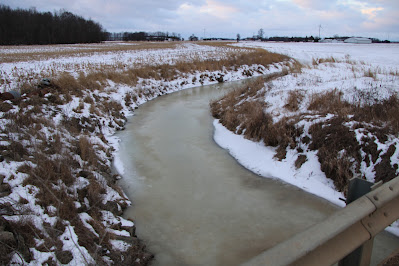It’s early morning with temperatures in the low 30’s, under mostly cloudy skies as I pause on the Pierce Rd. bridge and look north at a 10 ft-wide channel of the Bad River, covered with a thin layer of slushy ice. In the water right below the bridge, I observe a small school of 2-3 inch minnows swimming upstream. In all, there are more than 50 species of minnows found across our Great Lakes waterways. A variety of shiners, daces, minnows, and chubs offer examples of the small silvery fish that we commonly think of when we say ‘minnow.’ (stock photo). Proceeding north, I look across at the far bank to see what appears to be a snow slide made by a river Otter. Like gleeful kids, this playful mammal likes to slide down the slope and skid across the ice-covered channel. Down in the water, I notice another small school of minnows swimming downstream. Minnows, like many other fish school by using a combination of senses to navigate and maintain their position within the group. They have pressure-sensitive pores along their bodies called the lateral line. This line allows them to feel the vibrations created by other fish, which helps them maintain their position. They use their eyes to see where their neighbors are and what they're doing. Also, they use their sense of smell to detect chemical signals in the water that help them find and coordinate with other fish. Trudging along the bank, I feel a strong gust of wind and then hear the steady "whooshing/swishing" noise from the rotation of huge blades of a nearby wind turbine. This noise can negatively impact wildlife by disrupting mechanisms that crucial for their survival. In particular, it can reduce predator/prey behavior in some or cause them to flee the affected area, leading to habitat loss. This low-frequency sound and audible noise of a turbine can interfere with communication among many bird species, especially during courtship and nesting, Overall, noise like this alters animals’ communities and contributes to a decline of an ecosystem. Turning away from the river, I proceed back toward the car through an adjoining woodland where I come upon some yellow-stained snow from Whitetail urine. Depending on the deer's sex, reproductive status, and season, its urine contains compounds like creatinine, urea, electrolytes, and various organic acids, During breeding season, buck urine contains higher concentrations of pheromones which are crucial for attracting females. It is also used to mark territory. Doe urine is used to attract bucks during the rutting season.
Drifting snow grips the meadow
Old man winter has come to stay
Silence sweeps the forest edge
All the redwings have gone away
North wind brings arctic air
Ice conceals a verdant pond
Muskrats hide in their mounds
A crow calls from far beyond
In the midst of a cedar swamp
Sheltered from the bitter chill
Steam rising from its nostrils
A Whitetail deer stands still
D. DeGraaf

No comments:
Post a Comment